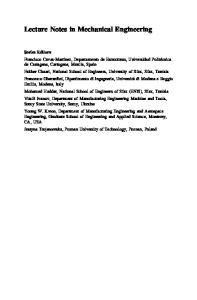Microstructural Modification and Surface Hardness Improvement in Al-Mo Friction Stir Surface Composites
- PDF / 3,046,679 Bytes
- 11 Pages / 593.972 x 792 pts Page_size
- 110 Downloads / 334 Views
JMEPEG https://doi.org/10.1007/s11665-020-05018-y
Microstructural Modification and Surface Hardness Improvement in Al-Mo Friction Stir Surface Composites V.P. Mahesh
, Ashutosh Kumar, and Amit Arora
(Submitted January 30, 2020; in revised form May 13, 2020) Molybdenum-reinforced aluminum matrix surface composites have been fabricated using friction stir processing. The Mo reinforcement results in an increase in the hardness and a decrease in the grain size. The Mo particle size and its dependence on the tool rotational speed are important for fabrication of highperformance composites. However, the effect of the tool rotational speed on microstructure, particle size and distribution, and hardness is not known. Here, we present microstructural and microhardness analysis of Al-Mo surface composites for varying tool rotational speeds. Increase in tool rotational speed results in reduced particle size, better particle distribution, and reduced grain size. The surface hardness also increases with an increase in the tool rotational speed. Keywords
aluminum, friction stir processing, molybdenum, surface composite, tool rotational speed
1. Introduction Surface composites possess the structural properties of the matrix metallic material along with the surface properties, such as hardness, wear, and corrosion resistance, of the composites (Ref 1-5). Liquid metal processing methods such as laser surface alloying (LSA) results in various defects such as porosity and interfacial reaction products due to melting and resolidification (Ref 6). Friction stir processing (FSP) is used for the fabrication of surface composites to overcome these defects (Ref 7-12). Better microstructural and mechanical properties can be achieved by FSP as there is no intermetallic formation (Ref 13-16). The finer grain structure developed by FSP restricts the dislocation movement resulting in higher hardness or strength for the processed materials (Ref 17). Aluminum (Al) and its alloys are used in strategic application owing to their high strength-to-weight ratio (Ref 18-21). Surface composites with transition metal reinforcement particles are fabricated by FSP (Ref 22, 23). Transition metal molybdenum (Mo) is a suitable reinforcement for Al matrix surface composites due to the very high melting point, high hardness, high modulus of elasticity and very low solubility in aluminum (Ref 24, 25). Arora et al. reported an increase in hardness of the surface composites upon molybdenum reinforcement in commercial aluminum alloy matrix using FSP (Ref 26). This increase in hardness is over and above the
V. P. Mahesh and Ashutosh Kumar have contributed equally to this work. V.P. Mahesh, Ashutosh Kumar, and Amit Arora, Advanced Materials Processing Research Group, Materials Science and Engineering, Indian Institute of Technology Gandhinagar, Gandhinagar, Gujarat 382355, India. Contact e-mail: [email protected].
Journal of Materials Engineering and Performance
increase in the hardness due to FSP without any reinforcement. The surface hardness improvement
Data Loading...











